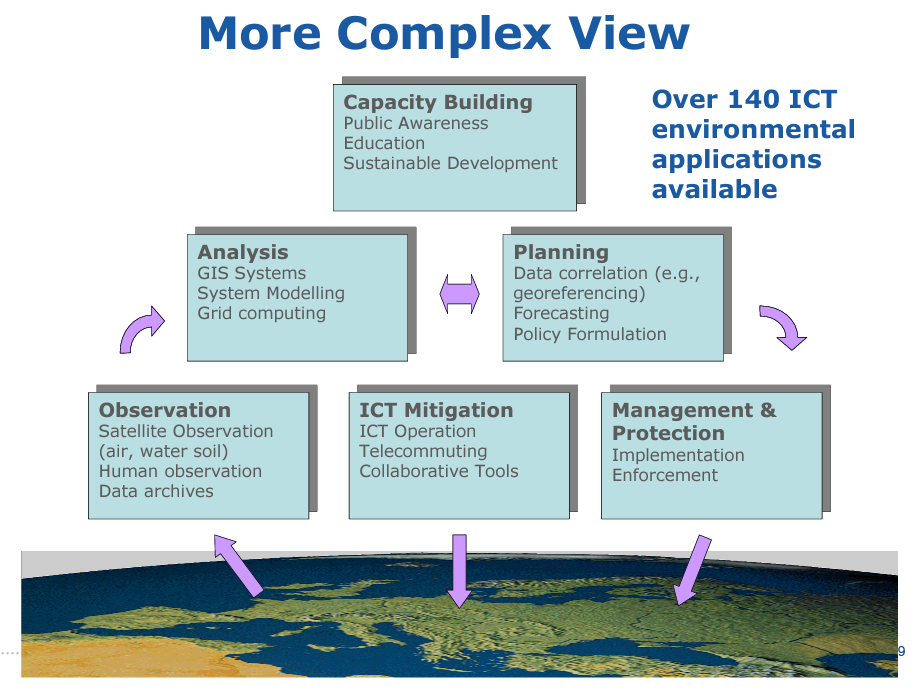
Why are cities important? Cities are growing at an accelerated rate. The global urban population is projected to grow by 2.5 billion between 2018 and 2050, with nearly 90 percent of the increase concentrated in Asia and Africa (UN, 2019). Cities encourage innovation, education, and economic opportunities. However, cities utilize the world’s resources unsustainably due to their constant growth. Cities consume 60-80% of energy and emit significant greenhouse gases (Albino, Berardi, & Dangelico, 2013). Today, we are witnessing two types of urban environments: the new city being built per the smart city model and retrofitting traditional consolidated cities with information and communication technologies (ICT).
Urbanists have tried to explain urban growth as an evolutionary process, even declaring death as a possible outcome. In Death and Life of the Great American City, Jane Jacobs promoted community wellbeing and economically sustainable neighborhoods. Her work epitomized the idea of vibrant self-sufficient neighborhoods with mixed-use housing blocks above small independent businesses, also known as mom and pop shops (Jacobs, 1961).

However, we are not living in the era of Jacob’s small neighborhoods or villages anymore. Our cities are densely populated and need to deal with waste generation, sustainable energy production, and vehicular traffic conditions, among other crises. In addition, most cities partake in the global economy and real-estate systems that produce a distinct neighborhood development. Therefore, the Smart City as a new ontology of the city is a domain of exchange between the evolution of digital technology, system thinking, urban sustainability, and other factors. I have been interested in this new urban scenario since I read William Mitchell’s City of Bits (1995). Mitchell wrote for an architectural audience and emphasized the digital as a medium that would eventually change how we perceive urban and architectural space. “We are all cyborgs now. Architects and urban designers of the digital era must begin by re-theorizing the body in space” (MItchell, 1995). Today, the city of bits has been redefined or re-interpreted as the smart city.

Defining the smart city has been a daunting task, primarily since the impetus originated in the technology sector rather than in urban studies. Cities designed and built under the umbrella of ICT’s have been heavy-handled by large corporative structures such as ATT, Cisco, Google, Oracle, Microsoft, among other industries that manage large volumes of consumer data. This is why critics tend to be belligerent about the smart city as ‘the future of urban development. Author Ben Greene advises that we cannot rely solely on technology to achieve a just and democratic city. He advocates for a smart city that implements technologies for specific purposes and entrusts social and political democratic processes with human methods (Greene, 2019). Therefore, a concise or holistic definition might not be possible. Moreover, a smart city that deploys ICT systems might be the current epistemological interpretation at work.

In Smart Cities: definitions, dimension, and performance, the authors produced an extensive table of possible definitions for the term. The definitions listed vary in-depth, and some include concepts outside technology (political, social, environmental), rendering a more holistic view of the smart city (Albino, Berardi, & Dangelico, 2013). However, the Smart City has a subset of topics that include but are not limited to the natural environment, creative activities, and human wellbeing in its physical and psychological manner.
The future use of information and communication technology in the administration and operation of a city is inevitable. However, a relevant question would be, what is the conceptual drive to make the city “smarter”? Can the technologies employed in the future city empower citizens and promote a more democratic and just built environment? Is the smart city a possible disruptive technology that can produce an alternative post-capitalist world? It would be essential to postulate if the smart cities can evolve into an open technological system “to render the city more informal” (Sennet, 2012). Moreover, where knowledge allows the creation of a new kind of sovereignty.
Works Cited
Albino, V., Berardi, U., & Dangelico, R. M. (2013). Smart Cities: Definitions, dimensions, and performance. Proceedings IFKAD, 1723-1738.
Chen, S. (2022, January 20). Smart City Concept Powepoint Presentation. Norman, Oklahoma, USA.
Greene, B. (2019). The Smart Enough City. Cambridge: MIT Press.
Jacobs, J. (1961). The Death and Life of the Great American City. New York: Random House.
MItchell, W. J. (1995). City of Bits: Space, Place and the Infobahn. Boston: MIT Press.
Sennet, R. (2012, December). Urban Age. Retrieved from The Stupefying Smart City: https://urbanage.lsecities.net/essays/the-stupefying-smart-city
UN. (2019). https://population.un.org/wup/Publications/. Retrieved from World Urbanization Prospects The 2018 Revision: http://esa.un.org/unpd/wup/index.htm
Qué es una ciudad inteligente
¿Por qué son importantes las ciudades? Las ciudades están creciendo a un ritmo acelerado. Se prevé que la población urbana mundial crezca en 2500 millones entre 2018 – 2050, y que casi el 90% del aumento se concentre en Asia y África (ONU, 2019). Las ciudades fomentan la innovación, la educación y las oportunidades económicas. Sin embargo, las ciudades utilizan los recursos del mundo de forma insostenible debido a su constante crecimiento. Las ciudades consumen entre el 60 y el 80% de la energía y emiten importantes gases de efecto invernadero (Albino, Berardi y Dangelico, 2013). En la actualidad, existen dos tipos de entornos urbanos: la nueva ciudad que se construye según el modelo de ciudad inteligente y la readaptación de las ciudades tradicionales consolidadas con tecnologías de la información y la comunicación (TIC).
Los urbanistas han tratado de explicar el crecimiento urbano como un proceso evolutivo, incluso declarando la muerte como un posible resultado. En Muerte y Vida de las Grandes Ciudades, Jane Jacobs promovía el bienestar de la comunidad y los barrios económicamente sostenibles. Su obra describía la idea de barrios autosuficientes y vibrantes con unidades de viviendas de uso mixto sobre pequeños negocios independientes, también conocidos como tiendas mom and pop (Jacobs, 1961).
Sin embargo, ya no vivimos en la época de los pequeños barrios o villas de Jacob. Nuestras ciudades están densamente pobladas y tienen que lidiar con la generación de residuos, la producción de energía sostenible y las condiciones del tráfico de vehículos, entre otras crisis. Además, la mayoría de las ciudades participan en la economía global y en los sistemas inmobiliarios que producen un desarrollo inmobiliario distinto. Por tanto, la Smart City como nueva ontología de la ciudad es un ámbito de intercambio entre la evolución de la tecnología digital, el pensamiento sistémico, la sostenibilidad urbana y otros factores. Me ha interesado este nuevo contexto urbano desde que leí la obra de William Mitchell City of Bits (1995). Mitchell escribía para un público de arquitectura y destacaba lo digital como un medio que acabaría cambiando la forma en que percibimos el espacio urbano y arquitectónico. “Ahora todos somos ciborgs. Los arquitectos y diseñadores urbanos de la era digital deben empezar por re-teorizar el cuerpo en el espacio” (MItchell, 1995). Hoy en día, la ciudad de los bits se ha redefinido o reinterpretado como la ciudad inteligente.
Definir la ciudad inteligente ha sido una tarea de enormes proporciones, principalmente porque el ímpetu se originó en el sector tecnológico y no en los estudios urbanos. Las ciudades diseñadas y construidas bajo el modelo de las TIC han sido manipuladas por grandes estructuras corporativas como ATT, Cisco, Google, Oracle, Microsoft, entre otras industrias que administran grandes volúmenes de datos de los consumidores. Por ello, los críticos tienden a ser beligerantes con la ciudad inteligente como “el futuro del desarrollo urbano”. El autor Ben Greene aconseja que no podemos confiar únicamente en la tecnología para conseguir una ciudad justa y democrática. Aboga por una ciudad inteligente que implemente tecnologías con fines específicos y confíe los procesos democráticos sociales y políticos a métodos humanos (Greene, 2019). Por lo tanto, una definición concisa u holística podría no ser posible. Además, una ciudad inteligente que despliega sistemas de TIC podría ser la interpretación epistemológica actual en funcionamiento.
En Smart Cities: definitions, dimension, and performance (Ciudades inteligentes: definiciones, dimensión y rendimiento), los autores elaboraron una extensa tabla de posibles definiciones del término. Las definiciones enumeradas varían en profundidad, y algunas incluyen conceptos ajenos a la tecnología (políticos, sociales, medioambientales), lo que aporta una visión más holística de la ciudad inteligente (Albino, Berardi y Dangelico, 2013). Sin embargo, la ciudad inteligente cuenta con un subconjunto de temas que incluyen, entre otros, el entorno natural, las actividades creativas y el bienestar humano en su vertiente física y psicológica. Después de 30 años han surgido nuevas variaciones sobre el tema. Ciudad digital, con un enfoque tecnológico de la comunicación y los sistemas digitales (Ishida, 2002). Ciudades Inteligentes, tecnologías TIC integradas en las infraestructuras existentes (en inglés las palabras Smart y Inteligent no aluden a lo mismo) Komninos (2014). Informática Urbana, incluye las TIC dentro de las funciones administrativas y organizativas (Batty, 2013) (Foth 2011). Smart City como concepto no representa un modelo holístico de desarrollo urbano.
La utilización de la tecnología de la información y la comunicación (TIC) en la administración y el funcionamiento de una ciudad es inevitable. Sin embargo, una pregunta pertinente sería: ¿cuál es el valor conceptual para hacer la ciudad “más inteligente”? ¿Pueden las tecnologías empleadas en la ciudad futura empoderar a los ciudadanos y promover ciudades más democráticas y justas? ¿Es la ciudad inteligente una posible tecnología disruptiva que puede producir un mundo post-capitalista y alternativo? Sería esencial postular si las ciudades inteligentes pueden evolucionar hacia un sistema tecnológico abierto “para hacer la ciudad más informal” (Sennet, 2012). Al mismo tiempo, donde el conocimiento permite la creación de un nuevo tipo de soberanía.
Traducción realizada con la versión gratuita del traductor www.DeepL.com/Translator
Bibliogafia
Albino, V., Berardi, U., & Dangelico, R. M. (2013). Smart Cities: Definitions, dimensions, and performance. Proceedings IFKAD, 1723-1738.
Batty, M. (2013). The new science of cities. MIT press.
Chen, S. (2022, January 20). Smart City Concept Powerpoint Presentation. Norman, Oklahoma, USA.
Foth, M., Choi, J. H. J., & Satchell, C. (2011, March). Urban informatics. In Proceedings of the ACM 2011 conference on Computer supported cooperative work (pp. 1-8).
Greene, B. (2019). The Smart Enough City. Cambridge: MIT Press.
Ishida, T. (2002). Digital City Kyoto. Communications of the ACM, 45(7), 76-81.
Jacobs, J. (1961). The Death and Life of the Great American City. New York: Random House.
Komninos, N. (2014). The age of intelligent cities: smart environments and innovation-for-all strategies. Routledge.
Mitchell, W. J. (1995). City of Bits: Space, Place and the Infobahn. Boston: MIT Press.
Sennet, R. (2012, December). Urban Age. Retrieved from The Stupefying Smart City: https://urbanage.lsecities.net/essays/the-stupefying-smart-city
UN. (2019). https://population.un.org/wup/Publications/. Retrieved from World Urbanization Prospects The 2018 Revision: http://esa.un.org/unpd/wup/index.htm
